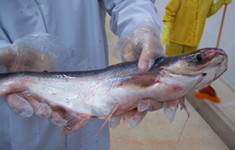
The Vietnamese authorities should select standards for producing pangasius to facilitate exports, according to Duong Ngoc Minh, chairman of the Freshwater Fish Committee of the Vietnam Association of Seafood Exporters and Producers (VASEP).
Vietnamese pangasius producers now have to comply with multiple sets of standards, he said, including Aquaculture Stewardship Council (ASC), GlobalGap and The Global Aquaculture Alliance’s Best Aquaculture Practice (BAP), depending on which market they are selling to.
During the past ten years, Vietnam’s pangasius production had risen sharply from tens of thousands of tons to more than one million tons per year, Minh said. Companies had focused on selling, but had ignored the standards for pangasius that foreign consumers require, he added.
Every year, the state spends heavily to help local seafood firms participate in seafood fairs in Europe and the U.S., but there has been no plan for building a Vietnamese pangasius brand, he remarked.
Therefore, foreign countries could stop importing Vietnamese pangasius when it fails to meet the standard on food safety or other standards. “We have no room to maneuver, so we are forced to apply GlobalGap in the European market, BAP in the U.S. and recently ASC in some European nations,” said Minh.
However, certification doesn’t come cheap for Vietnamese farmers. According to Minh, producing pangasius to meet the ASC standard means an investment of VND 50 million (USD 2,400; EUR 1,855) for each hectare of pond, or else each kg of fish will cost an additional VND 5 (USD 0.00024, EUR 0.0002), while prices of ASC-qualified pangasius are often USD 0.20-0.30 (EUR 0.15-0.23)per kg higher than the normal level.
This may seem an infinitesimal amount of money, but farmers in Vietnam are strapped for cash, particularly with the ever-increasing cost of feed, and while exporters are cutting each other’s throats to secure orders, every little counts.
At present, GlobalGap and ASC are both accepted in Europe, but ASC is preferred, Minh said. However, what Minh didn’t say was that it is the big supermarket chains which are insisting on these certification schemes to show that the fish they sell has been responsibly produced.
Whether the presence of an eco-label or logo on a pack has any effect on customers’ purchasing habits is open to question. None of the organizations behind these certification schemes makes any effort to tell consumers what they stand for. And pangasius needs all the help it can get to inspire consumer confidence, certainly in many northern European countries.
While people will purchase pangasius because it is cheap, they still have doubts about the way it is produced and this issue needs to be addressed. Earlier this year, Queens Products in the Netherlands celebrated ten years of selling pangasius by giving away free packs to residents of Varsseveld where the company is located. But that hardly constituted a sustained PR campaign.
VASEP has produced “Pangsius — 26 Q&A,” which it calls “the complete booklet about pangasius,” but this has been sent to seafood professionals so there is nothing to persuade consumers to buy the fish.
In its latest newsletter VASEP states that lower consumer demand was a major factor in pangasius exports declining by more than 10 percent in the third quarter of 2012 when compared with the same time last year.
In the words of one observer: “The pangasisus business is not back to normal. And I believe it will crawl back to normal only when there is a clear, loud and positive message given to the consumer.”
So as well as selecting standards for producing pangasius, the Vietnamese authorities should also be seeking to devise methods for promoting pangasius, because if consumers can’t be persuaded to buy what is produced then it doesn’t really matter what method is used to produce it.
Building the Vietnamese pangasius brand that Duong Ngoc Minh spoke about should be a top priority, but it should be targeted at consumers otherwise sales could slide still further.





